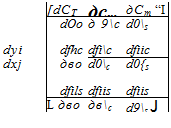General Numerical Trim Model
To conduct a validation of any wake model with experimental measurements, the rotor must be trimmed, and this requires an iterative procedure. For simplicity, only the rotor will be considered^ but as shown in Section 4.14 the airframe must also be considered for a proper free flight trim simulation. Recall that the rotor aerodynamic response, in general, is a highly coupled function of the control inputs and rotor aerodynamic environment. Therefore, although rotor thrust is controlled by the application of collective pitch, the blade flapping response is also affected. Likewise, cyclic pitch inputs not only produce a change in blade flapping response, but in rotor thrust as well. This coupling is a result of the induced aerodynamic effects trailed into the rotor wake, and its effect on the angles of attack over the rotor disk. The procedure necessitates several trim iterations before a converged solution is obtained.
The updates to the rotor control inputs at each trim iteration can be found using a Newton – Raphson approach applied to a linearized system of coupled equations that relate the rotor response vector to the control vector. If the control input vector is denoted by 3c, and the rotor response or output vector by y, then
|
‘ Oo |
Ст |
|||
|
у _ , |
0c |
’ and |
V = – |
Pic |
|
0s |
у |
Pis |
A first order Taylor expansion for the rotor response about x gives
![]() y(* + Ax) = y(x) + [У] Ax H———
y(* + Ax) = y(x) + [У] Ax H———
where y(x + A3c) is the rotor response as a result of the new control input vector {x + Ax}. Rearranging the terms in Eq. 10.98 gives
Ax = [j~l]{y(x +Ax)-y], (10.99)
where {у(х + Ax) — y} is a response error vector that will be denoted by ?(>■). Hence, Eq. 10.99 can be written in the following compact form
АЗс = [7_1]б(у). (10.100)
The matrix, [У] is known as the Jacobian matrix of the dependent quantities (response variables) in terms of the control inputs, and in terms of constituent elements is given by
 (10.101)
(10.101)
Notice that if the flight controls were uncoupled then [J] would have been a diagonal matrix with no interdependency between either the rotor thrust and cyclic inputs or between the
blade flapping and collective input. However, because of the complex 3-D aerodynamic coupling at the rotor, the Jacobian is fully populated.
To solve Eq. 10.100 numerically, the Jacobian matrix must first be determined. The partial derivatives in Eq. 10.101 can be approximated using first-order forward differences. This is done by first computing the rotor response vector corresponding to an initial guess control input vector. Subsequently, each input is independently perturbed and the rotor response recomputed to provide all the elements of [7]. Although computationally expensive to evaluate, for most problems the Jacobian matrix does not need to be recomputed each time the rotor is trimmed. The control input correction or update vector, Ax can be readily determined by solving Eq. 10.100 using standard matrix methods. The rotor control inputs can then be updated. Usually, however, some degree of numerical damping must be provided to ensure monotonic convergence of the solution to within a specified tolerance in rotor thrust and rotor flapping response.











